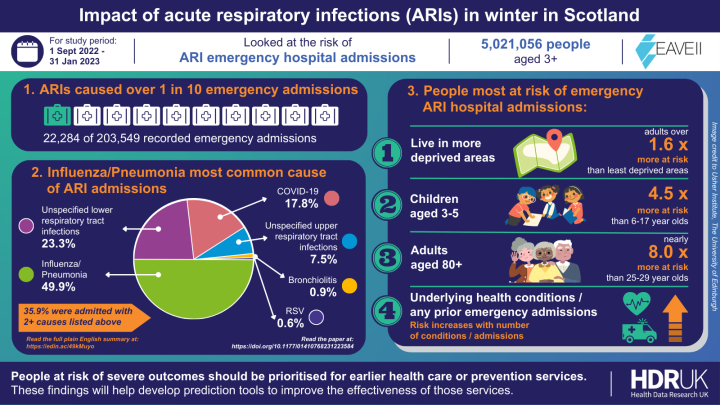Risk of winter hospitalisation and death from acute respiratory infections in Scotland
February 2024: Research published in the the Journal of the Royal Society of Medicine looks at the severity of acute respiratory infections across the winter period in Scotland.
Risk of winter hospitalisation and death from acute respiratory infections in Scotland: national retrospective cohort study
Shi, Ting; Millington, T; Robertson, C; Jeffrey, K; et.al
Journal of the Royal Society of Medicine
Published online on: 12 February 2024
Available online at: https://doi.org/10.1177/01410768231223584
Summary in plain English
Background
Acute respiratory infections (ARI) can make it difficult for a person to breathe normally.
Globally, these infections are responsible for high rates of disease, particularly in young children and older adults. Due to seasonal changes during winter, a person can be more at risk of getting ill with a virus. Examples of these viral infections include influenza, pneumonia, respiratory syncytial virus (RSV) and COVID-19.
This was significant in winter 2022, in addition to the NHS facing immense pressures due to the COVID-19 pandemic, cost-of-living crisis and staff demands.
Why did we carry out this work?
Previous research has explored the risk of ARIs in children and older adults with underlying health conditions such as chronic respiratory disorders, diabetes, and heart disease. However, there is limited research using whole population data.
In this study, we analysed national data to describe and identify risk factors for ARIs. We identified patterns focusing on people admitted to hospital or who passed away during the winter period in Scotland.
What data did we use?
We used the EAVE platform to access the routinely collected health data on 5.4 million residents of Scotland from 1 September 2022 to 31 January 2023.
Our dataset was made up of the de-identified, linked, GP, hospital admission, Intensive Care Unit (ICU) admission and death record data.
With this we looked at the emergency admissions of people who were either admitted because of a respiratory infection or were admitted for other reasons whilst also having an infection.
More specifically, we examined respiratory pathogens commonly associated with ARIs such as influenza, RSV and SARS CoV-2 (the strain of coronavirus that causes COVID-19).
We also considered characteristics such as a person's:
- History of emergency admissions
- Number of clinical risk groups
- Age
- Socio-economic status
- Sex
We further investigated whether a person experiencing an ARI could impact other areas of their treatment, such as the length of their hospital stay, likelihood of ICU admittance and death.
We also completed four additional sensitivity analyses which looks at the uncertainties of the data and determine the extent of how the results are affected.
This research had a few limitations:
- The study period took place over five months and resulted in small numbers of cases in subgroups ordered by factors that were compared against each other such as, RSV in adults and RSV, influenza, and SARS-COV-2 in children. This shows the need for more laboratory testing to maintain accurate records.
- This study used risk groups defined for adults, it may have overlooked child-specific groups and contributed to behavioural differences in seeking care.
- Some predictors were also excluded in the main analysis due to outdated or a lack of data such as, smoking status, reasons for hospital admission or the effect of vaccination on other health conditions. However, these parameters were included in the sensitivity analyses.
What did we find?

How many emergency admissions were due to ARIs?
We found that 22,284 (nearly 10%) of 203,549 recorded emergency admissions were due to ARIs.
Most of these cases were adults (20,525) but included children aged at least three years old as well (1,759).
Of these, 5% of people were admitted to the ICU and 7.4% of adults passed away (no children passed away).
Which ARIs were people admitted with?
The most common causes of ARI emergency admissions were:
- Influenza/pneumonia - 49.49%
- Unspecified lower respiratory tract infections - 23.3%
- COVID-19 - 17.8%
- Unspecified upper respiratory tract infections - 7.5%
- Bronchilitis - 0.9%
- Respiratory Syncytial Virus (RSV) - 0.6%
In addition, 35.9% of people were admitted with 2+ of the causes listed above.
Who is most at risk?
Overall, the people at greatest risk of experiencing an emergency winter ARI hospital admission were: younger children, older adults, those living in more deprived backgrounds, with one or more health conditions or a history of emergency admissions.
Adults living in the most deprived areas were over 1.6 times more at risk than those living in the least deprived areas. A similar pattern was seen among children.
Adults aged 80+ are nearly 8 times more at risk of an emergency ARI admission, compared to 25-29 year olds.
Children aged 3-5 were 4.5 times more at risk compared to 6–17-year-olds.
A person's vulnerability also increased with the number of prior emergency admissions (for any reason) they experienced, or the number of existing health conditions they were living with.
Why is this important?
Our results are important as they provide national-scale evidence on the factors that contribute to ARI winter hospitalisations.
We found that younger children, older adults, those living with underlying health conditions, a history of emergency admissions or live in more deprived areas are at greatest risk of experiencing an ARI hospital admission.
We believe that these individuals should be prioritised for earlier health care or prevention services.
Our results can also be used to help develop prediction tools that can help improve the effectiveness of these services, by identifying the people who would benefit most from earlier care. This could enhance individual support in the community and contribute to more effective healthcare management.
Notes
This summary was written by Patient and Public Involvement Officer, Anna Crawford. It was reviewed by members of our analyst team, as well as Patient and Public member Farzana K.
This page was first published on 19 February 2024.


